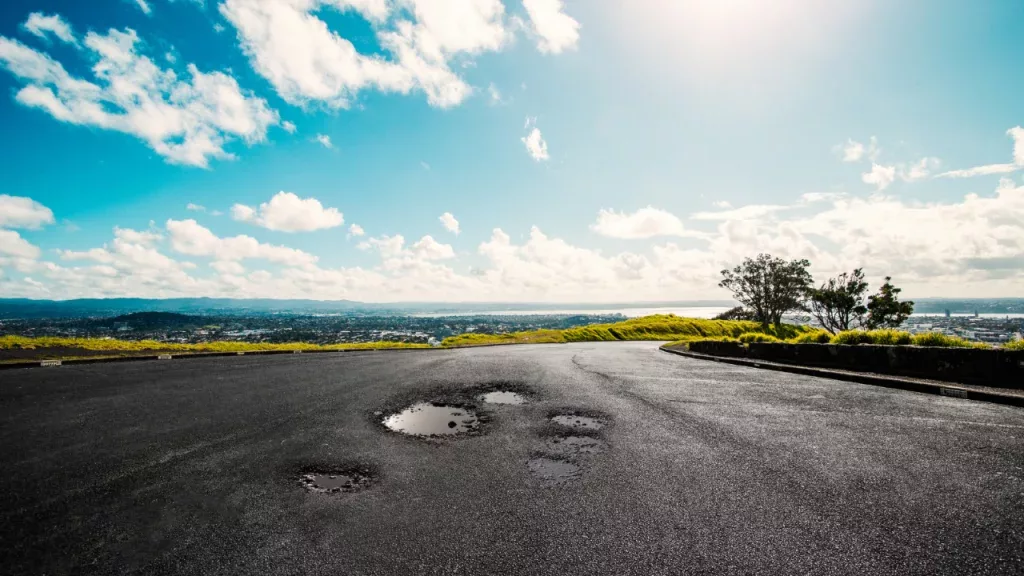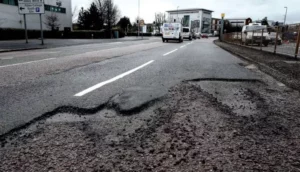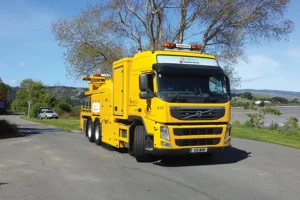A third of English councils’ B and C roads were rated in amber or red condition in the last year, according to the latest Department for Transport Road Condition statistics.
To the year ending March 2022, Local Authorities reported the proportion of:
- local ‘A’ roads that should have been considered for maintenance was 4%, unchanged for the past 3 years
- ‘B’ and ‘C’ roads that should have be considered for maintenance was 6%, unchanged for the past 6 years
- unclassified roads that should have been considered for maintenance was 15%, a small improvement from 17% in the previous 12 months. Unclassified roads continue to see greater yearly fluctuations than other roads
Paul Boss, Chief Executive of the RSTA: “We need to be ensuring local authorities are undertaking required preventative maintenance even if that is at the expense of structural maintenance to make sure we limit potholes forming. It’s about increasing sustainable and cost-effective treatments to stop the roads in green and amber condition falling into red. Local authorities need to ringfence preventative surface treatments as a priority on funding that is available., Ideally more funding is needed for local roads but there a still some local authorities that are not making the most efficient use of the funds they have available to them. The RSTA will be producing carbon and sustainability guidance soon to help with them this.”

Road surface condition categories are based on multiple parameters collected by Surface Condition Assessment for the National Network of Roads (SCANNER) machines and scored against different definitions for different types of road. This is so that maintenance is prioritised for roads that are more frequently used. This means that the proportion of ‘red’ roads is not comparable across road classes (for example, “A”, “B”, “C” and “U”). For example, an A’ road categorised as red could be in identical condition to a ‘B’ road categorised as amber.
Road Condition Surveys Used by Local Authorities
Although current requirements specify that SCANNER surveys should be carried out by Local Authorities on their classified road network (Motorways, ‘A’, ‘B’ and ‘C’ roads), other surveys have been used by Local Authorities. In the year ending March 2022, 80% of Local Authorities used SCANNER surveys on their ‘A’ road network and 79% used it on the ‘B’ and ‘C’ networks. This is a fall from 99% on ‘A’ roads and 98% of ‘B’ and ‘C’ roads in the year ending March 2018. The data in this publication is based on responses from both those Local Authorities using SCANNER and those who have supplied alternatives.
In response to the changing landscape of road condition monitoring surveys available to Local Authorities, the Department for Transport (DfT) are working to produce a new Data Standard to allow for multiple technologies but ensure data comparability and integrity across the different survey approaches. A position paper for the Data Standard has been published on this review of road condition data and technology.
Condition of Local ‘A’ Roads
Local ‘A’ roads and motorways account for around 9% of the Local Authority managed road network in England and carry approximately one-third of all traffic. Local Authorities are required to carry out SCANNER surveys on 90% of their ‘A’ roads and motorways over a 2-year period, therefore the data presented for the year ending March 2022 was collected between April 2020 and March 2022.

In the year ending March 2022, 4% of local ‘A’ roads were categorised as red. The majority of roads were categorised as green at 72%, followed by amber at 24%. These proportions remained the same as those seen in the year ending March 2021.
The percentage of local ‘A’ roads categorised as red has remained at 4% since the year ending March 2020. Despite a slight increase from 3% in the year ending March 2019, the proportion of these roads categorised as red is still below levels seen in the year ending March 2008.

The proportion of roads categorised as red varies across the country, as demonstrated in Chart 4.

Of the 109 Local Authorities that provided data for the year ending March 2022, 46 Local Authorities reported 2% or fewer red ‘A’ roads, while 3 Local Authorities reported greater than 10%.
When looking at the proportion of ‘A’ roads categorised as red over time:
- 79% of Local Authorities reported an improvement or no change in the proportion of ‘A’ roads categorised as red between the years ending March 2013 and 2022, where data was available for both time periods
- looking at shorter term trends, 60% of Local Authorities reported an improvement or no change in the proportion of red ‘A’ roads since the year ending March 2019
‘B’ and ‘C’ roads together account for around 28% of all roads in England. Local Authorities are expected to carryout SCANNER surveys on 85% of their ‘B’ road and 80% of their ‘C’ road networks over a 2-year period. The data presented for the year ending March 2022 will have been collected between April 2020 and March 2022.

In the year ending March 2022:
- for ‘B’ and ‘C’ roads, 6% were categorised as red
- while 28% of roads were amber
- the majority of roads were green, at 66%
Since the year ending March 2021, there was an improvement in the proportion of roads categorised as green, from 64% to 66% for year ending March 2022. There was a slight fall in the proportion of amber roads, from 29% to 28%, and red remained at 6%. Figures may not sum due to rounding.

After reaching a peak in the years ending March 2010 and March 2011, where 10% of ‘B’ and ‘C’ roads were categorised as red, the proportion fell to 6% in the year ending March 2016. Figures have remained stable at 6% since the year ending March 2016.

In the year ending March 2022, around a quarter of Local Authorities reported 2% or fewer red ‘B’ and ‘C’ roads, while 7 Local Authorities reported greater than 10%.
When looking at the proportion of ‘‘B’ and ‘C’ roads categorised as red over time:
- where data was available for both time periods, 87% of Local Authorities reported an improvement or no change in the proportion of ‘B’ and ‘C’ roads categorised as red between the years ending March 2013 and March 2022
- more recently, since the year ending March 2019, 66% of Local Authorities reported an improvement or no change in the proportion of red ‘B’ and ‘C’ roads
The proportion of the unclassified road network categorised as red has fluctuated between 15% and 18% since measurement started in March 2007, and currently stands at 15%.
The Strategic Road Network (SRN) is made up of the motorways and major trunk roads in England that are managed by National Highways (NH). These roads account for around 2% of the road network in England but carry approximately one-third of all traffic. TRAffic-speed Condition Surveys (TRACS) are carried out on the full SRN each year. The year ending March 2022 data was collected between April 2018 and March 2022 with most of the data from the last 2 years.
For roads that make up the SRN in the year ending March 2022:
- for motorways, 4% should have been considered for maintenance
- for ‘A’ roads, 7% should have been considered for maintenance
Both of these figures have remained at the same level since the year ending March 2019.

National Highways’ management of the SRN is also monitored by the Office of Rail and Road (ORR), who produced a report covering April 2021 to March 2022 on this, which includes a road condition metric and target. Overall, 95.5% of the SRN did not require further investigation in the year ending March 2022, exceeding the target within their key performance indicator of at least 95%. This key performance indicator has now been met for the last 5 years.
The methods used by NH to calculate this measure of condition vary from those presented in this report for surface condition and skidding resistance, therefore are not directly comparable. See the Technical Note for further information on these differences.
Skidding resistance
Skidding resistance surveys are undertaken by Local Authorities and NH. They provide a measure of the road surface contribution to the frictional forces developed between a vehicle’s tyres and the road when accelerating, braking, or cornering.
Skidding resistance surveys are undertaken by Local Authorities and NH. They provide a measure of the road surface contribution to the frictional forces developed between a vehicle’s tyres and the road when accelerating, braking, or cornering.
In the year ending March 2022, for skidding resistance:
- of the motorways that are part of the SRN, 4% required further investigation, the same level as the previous year’s figures
- for strategic ‘A’ roads, this decreased by 1 percentage point since the previous year to 11%
- for local roads, 30% of the motorway and ‘A’ road network in England required further investigation in the 3-year period from the years ending March 2020 to March 2022. This was an increase on the 3-year period from the years ending March 2019 to March 2021
Different types of treatment are applied to sections of road to preserve, repair or improve the condition of the road. These are influenced by factors such as weather, funding and nature of the defect requiring treatment. The type of road selected for treatment by a Local Authorities is likely to include a broader group of roads than just those categorised as red.
In the year ending March 2022:
- for local ‘A’ road network (excluding motorway), 5.8% and 2.7% of the minor road network (‘B’, ‘C’ and unclassified roads) received maintenance treatments, a slight increase for ‘A’ roads and a slight decrease for minor roads on the previous year
- surface dressing accounted for over half of all treatments on local ‘A’ roads and the majority of all minor roads (59% and 70% respectively)






















